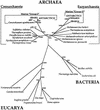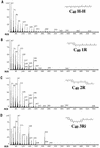Dibiphytanyl ether lipids in nonthermophilic crenarchaeotes
- PMID: 9501451
- PMCID: PMC106379
- DOI: 10.1128/AEM.64.3.1133-1138.1998
Dibiphytanyl ether lipids in nonthermophilic crenarchaeotes
Erratum in
- Appl Environ Microbiol 1998 May;64(5):1986
Abstract
The kingdom Crenarchaeota is now known to include archaea which inhabit a wide variety of low-temperature environments. We report here lipid analyses of nonthermophilic crenarchaeotes, which revealed the presence of cyclic and acyclic dibiphytanylglycerol tetraether lipids. Nonthermophilic crenarchaeotes appear to be a major biological source of tetraether lipids in marine planktonic environments.
Figures




References
-
- Chappe B, Albrecht P, Michaelis W. Polar lipids of archaebacteria in sediments and petroleums. Science. 1982;217:65–66. - PubMed
-
- Chappe B, Michaelis W, Albrecht B, Ourisson G. Fossil evidence for a novel series of archaebacterial lipids. Naturwissenschaften. 1979;66:522–523.
Publication types
MeSH terms
Substances
LinkOut - more resources
Full Text Sources

